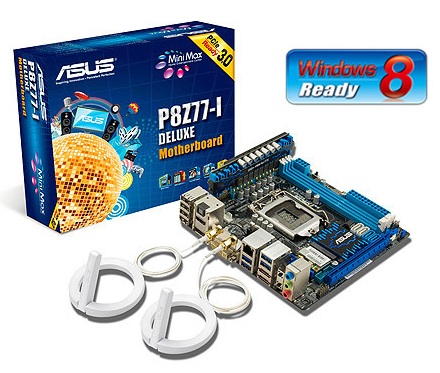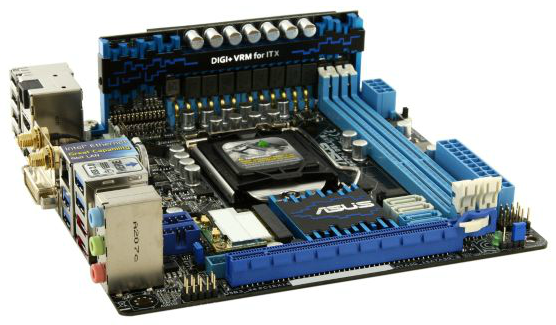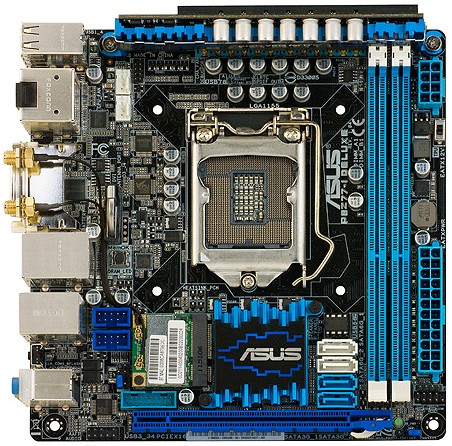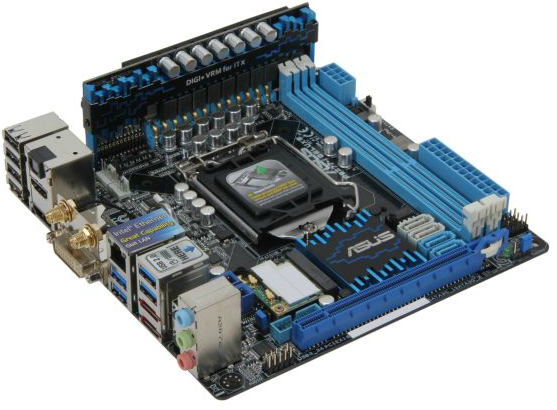Z77 mITX Round-Up: Five of the Best – MSI, Zotac, ASRock, EVGA and ASUS
by Ian Cutress on December 31, 2012 7:00 AM EST- Posted in
- Motherboards
- MSI
- ASRock
- EVGA
- ZOTAC
- Asus
- Ivy Bridge
- Z77
- mITX
ASUS P8Z77-I Deluxe Overview
Consumer grade motherboards are for the most part two dimensional affairs – the only PCB related paraphernalia that would impinge on the z-direction are the modular components that enhance the experience, such as memory and graphics. Now take the original point and turn it on its head, and we get the P8Z77-I Deluxe. In order to save space on the mini-ITX sized motherboard for controllers and added features, ASUS have taken a leaf out of the server space and placed the power delivery for the motherboard perpendicular to the motherboard. As crazy as it sounds, the setup is tastefully done by careful planning and precision engineering.

Alongside the funky VRM placement, ASUS are also one of the few Z77 mITX manufacturers with the socket and the chipset the more ‘common’ way around when put alongside full sized ATX boards. This should give the socket more room when dealing with larger air coolers, however we are still up against the memory slots (as expected) and it is only a short distance to the rear IO panel and the power delivery daughter board. But the plus side is also in the 8-pin CPU power connector placement, which is on the other side of the memory slots. There is also room to fit a TPU switch, a MemOK button, two USB 2.0 ports, a USB 3.0 port, a 2.5/5 GHz WiFi module and a pair of fan headers on board. The WiDi version of this motherboard looks identical apart from WiDi capabilities for around $15 more.
Connectivity and controller selection are an important aspect for a mITX design, and ASUS have furnished the P8Z77-I Deluxe with more USB ports and connectivity at the rear IO than most boards in this roundup. A total of eight USB ports on the rear (four USB 2.0, four USB 3.0), as well as DVI-I, HDMI, DisplayPort, eSATA, BIOS Flashback, an Intel NIC and Realtek ALC898 audio (via three jacks rather than the standard six). The front panel audio header is in a really odd place, and easily interferes with a large gaming GPU.
Followers of my reviews will see a familiar face in the ASUS BIOS and Software departments. The BIOS is an easy mode front screen with additional advanced mode, giving overclock options as well as DIGI+ Power configuration details. Previous experience often tells me that ASUS BIOSes are often the more configurable and compatible with my memory kits than most, and I have nothing to say that the mITX board would contradict that. The software package comes in the form of AI Suite and covers all the bases software should cover – overclock options, monitoring (warning when things get too hot), fan controls with RPM detectors, energy saving options, WiFi controls, fast charging utilities, USB 3.0 Boost, Network iControl, USB BIOS Flashback options and BIOS updating.
In terms of benchmark performance, the P8Z77-I Deluxe takes an extraordinary win in our WinRAR test, beating the other mITX Z77 boards by 5-20%. I redid this test after a reboot, a fresh install, a re-flash of the latest BIOS and it remained consistent. Whatever ASUS put in the BIOS, WinRAR seems to fly. The other CPU benchmarks were more ballpark, but the gaming results seemed to swing towards the ASUS. With the USB 3.0 boost functionality, we got great results in our USB 3.0 testing as well under Windows 7. Power delivery for the ASUS P8Z77-I was also favorable in our setup.
For an all-in price of $185 for the normal version of the P8Z77-I Deluxe and $200 for the WiDi enabled P8Z77-I Deluxe/WD, we are stretching near the top of our mITX range pricing bracket – only the EVGA Z77 Stinger is more expensive, and the others are circling around the $150-$160 margin. This ASUS board pulls ahead on performance, usability and software, and the design is new and exciting. Consistent functionality from ASUS products such as USB BIOS Flashback, USB 3.0 Boost, MemOK! and numbers of ports should not be overlooked lightly, and if you are looking for one of the best all-around mITX board for a build, the ASUS P8Z77-I Deluxe pulls out a big lead. However, the positioning of that front panel audio header gives cause for concern.
Visual Inspection
All eyes on the P8Z77-I Deluxe immediately focus on the VRM add-in board. It is hard to miss, and makes the motherboard aesthetically different to its rivals.

There are some questions that come up from this sort of arrangement – connectivity, power delivery, electrical losses, electrical noise, stability, and so on. Crucially the path of the power is most interesting – the 8-pin CPU power connector is on the top right of the motherboard, and this power is taken up into the daughterboard, filtered, and then passed back through into the motherboard for the processor. On the left of the daughterboard we have a series of normal pins used for control of the power delivery – issuing commands for the ‘DIGI+’ part of the system. The rest of the daughterboard is connected firmly with thicker copper pipes – mostly for rigidity but behind this is hiding the transfer of power to the board. The capacitors in front of the power delivery provide the final filtering mechanism before the CPU gets the power. The result is essentially a custom power solution, allowing ASUS to add in any height of daughterboard for any number of phases or power delivery capability. We may see something similar if ASUS ever decide to bring out a mITX Republic of Gamers product, but I would not expect a 32 phase monster to arrive in similar fashion any time soon (and it is debatable if 32 phases is even needed). There is also scope for adding something similar on mATX and ATX boards.

On close inspection readers may notice the ‘lack’ of mounting holes for the motherboard at the top. In order for everything to go as planned, ASUS use the two normal top holes to fix the power delivery daughterboard in place. The screws holding the board in can be removed, and ASUS has included two longer threaded screws in the box such that users can fasten the board into case standoffs. It is a little trickier if users have the push-pin type standoffs, such as those used in test beds.
The rest of the motherboard uses the extra space to add in all of ASUS’ favorite controllers. We have two four-pin fan headers at the top left of the board, suitable for a CPU fan and a case fan, as well as the TPU/EPU controllers and the motherboard battery is raised out of the board at right angles rather than the typical flat scenario. Below the battery is the MemOK! button, used when a memory overclock goes AWOL rather than a blanket Clear_CMOS button. Two USB 2.0 headers lie to the side of the WiFi module which itself is connected by a pair of wires to the rear IO panel for the magnetic antenna included in the box. The USB 3.0 header is hiding below the WiFi module, as well as the Realtek ALC898 audio codec chip. The location of this USB 3.0 header could be of concern due to either the location of the USB 3.0 case ports (typically on the front), or if a GPU with a backplate is used.

The chipset is underneath the electric blue heatsink in the middle of the bottom of the board, and on the right of this are our SATA ports – two SATA 6 Gbps and two SATA 3 Gbps. With the SATA ports all facing the same way we get the issue that if the bottom one needs to be removed, the ones above have to be taken out and put back in again. This is not an ideal scenario, and apart from spacing out the ports a little more, I cannot think of a better solution.
The PCIe slot at the bottom board is where we expect to find it, although front panel audio is to the left of this and would quite easily get in the way of any installed graphics card. This a really odd placement for the audio header, it baffles and confuses me in a number of ways, as someone at ASUS after designing the rest of the motherboard turned round and said that this placement was a good idea. It would have never got past my stamp of approval that is for sure.
On the right hand side of the board are our power connectors, a TPU switch and the front panel header. All that is missing here is a two-digit debug, and perhaps a power/reset switch. While not 100% necessary, for anyone used to building or debugging computers, they are a god-send when dealing with potential issues. At least a two-digit debug would be appreciated.

As mentioned in the overview, the IO of the P8Z77-I Deluxe is one of the more fruitful bounties in this mITX roundup. From left to right we have four USB 2.0 ports, an optical SPDIF output, HDMI, DisplayPort, two antenna placements, a combination DVI-I, an Intel NIC, four USB 3.0 ports (two from the chipset, two from an ASMedia controller), two eSATA 3 Gbps, a USB BIOS Flashback button, a Clear_CMOS button, and a trio of Realtek ALC898 audio jacks.
Board Features
| ASUS P8Z77-I Deluxe | |
| Price | Link |
| Size | Mini ITX |
| CPU Interface | LGA-1155 |
| Chipset | Intel Z77 |
| Memory Slots |
Two DDR3 DIMM slots supporting up to 16 GB Up to Dual Channel, 1066-2400 MHz |
| Video Outputs |
DVI-I HDMI DisplayPort |
| Onboard LAN |
Intel 82579V 802.11 b/g/n WiFi 2.5 GHz + 5 GHz |
| Onboard Audio | Realtek ALC898 |
| Expansion Slots |
PCIe 3.0 x16 mini-PCIe |
| Onboard SATA/RAID |
2 x SATA 6 Gbps (Chipset), RAID 0, 1, 5, 10 2 x SATA 3 Gbps (Chipset), RAID 0, 1, 5, 10 2 x eSATA 3 Gbps (Chipset), RAID 0, 1, 5, 10 |
| USB |
4 x USB 3.0 (Chipset) [2 back panel, 2 onboard] 2 x USB 3.0 (ASMedia 1042) [2 back panel] 8 x USB 2.0 (Chipset) [4 back panel, 4 onboard] |
| Onboard |
2 x SATA 6 Gbps 2 x SATA 3 Gbps 2 x USB 2.0 Headers 1 x USB 3.0 Header 1 x MemOK! Button 2 x Fan Headers 1 x mPCIe with WiFi Module 1 x TPU Switch Front Panel Audio Header |
| Power Connectors |
1 x 24-pin ATX Power Connector 1 x 8-pin CPU Power Connector |
| Fan Headers |
1 x CPU (4-pin) 1 x CHA (4-pin) |
| IO Panel |
4 x USB 2.0 1 x Optical SPDIF Output 1 x HDMI 1 x DisplayPort 2 x Antenna 1 x DVI-I 1 x Intel 82579V NIC 4 x USB 3.0 2 x eSATA 3 Gbps 1 x Clear_CMOS Button 1 x USB BIOS Flashback Button Audio Jacks |
| Warranty Period | 3 Years |
| Product Page | Link |
An interesting distinction to make between all the mITX boards in this roundup is that those on the higher cost end of the spectrum are using Intel NICs, whereas the cheaper models all go with Realtek. The same thing cannot be said with audio codec, with some low end models using the ALC898 and a high end model using the ALC889. Thankfully though the ASUS here is using the ALC898, and also has access to 6 USB 3.0 ports overall on top of 8 USB 2.0 ports.
Downsides start with the front panel audio header placement, the lack of mSATA (compared to some of the cheaper models) and no two-digit debug (but that may just be a personal preference). The use of the daughterboard for the power delivery should have opened up a little more opportunity in terms of placement of these headers, but even with the extra space it is a tight squeeze with all the ASUS features such as the TPU and USB BIOS Flashback to take into consideration. Perhaps the two-digit debug could have been on the daughterboard?










54 Comments
View All Comments
Etern205 - Saturday, January 5, 2013 - link
Here is another model, that supports WiDihttp://www.asus.com/Motherboards/Intel_Socket_1155...
zilexa - Friday, January 11, 2013 - link
Will the upcoming Intel CPUs with integrated GTe graphics chip fit on these mobo's? If so these mITX mobos are VERY futureproof and ideal for an HTPC.doubledd - Wednesday, April 10, 2013 - link
I recently built a mini itx with the MSI Z77IA-53, Cooler Master Elite 120, Antec Kuhler 620, 16gb 1.35V ballistic memory, a 690GTX, a 3570k, default timings and a msata plextor SSD. Except the video card, the system was dirt cheap. With the card, 3D Mark 11 score of X6037.Removal of the HDD cage was all that was required to make room for the radiator to mount to the existing front fan on this $45 case. Folding 100% load processor is 64 degrees....not great, but manageable for this BEAST.
While I consider Anandtech to be one of my trusted sources in reviews, I find it disappointing that they could be reviewing mini itx systems and yet be so out of touch with what people actually use these for. These are lan boxes or HTPCs and are supposed to be small and quiet. Why anyone would want a 8" tall by 8" diameter fan is beyond me. These boards are hardly bigger than a post card. Things are gonna be tight. Think out of the box a bit huh? There are quite a few mini-itx cases that can run or be modded with little effort to run, quiet liquid cooling.
It reminds me of the Consumer reports worst cars of 2013. Half of them are off road vehicles. The complaints are about suspension, shifting and road noise......no kidding?
castl3bravo - Sunday, June 23, 2013 - link
I have found the Asus BIOS for my P8Z77-I Deluxe to be an abysmal mess. My CPU ratio is permanently stuck at 42. During some change of a setting or an upgrade to the latest BIOS, ASUS shoved a "hidden" ME upgrade as well. This process somehow corrupted my BIOS so now I can't overclock beyond ratio of 42.There are other ASUS P8Z77 based m/b's having the same issue. I would suggest Anand have his team research the forums first before writing such glowing reviews of the BIOS for a vendor. I bought this board based on, what appears to be, an inexperienced review last year. Reading this followup on the BIOS is laughable--perhaps even negligent.
Here is but one example of the drama people are going through with this messed up BIOS.:
http://forums.anandtech.com/showthread.php?t=23143...